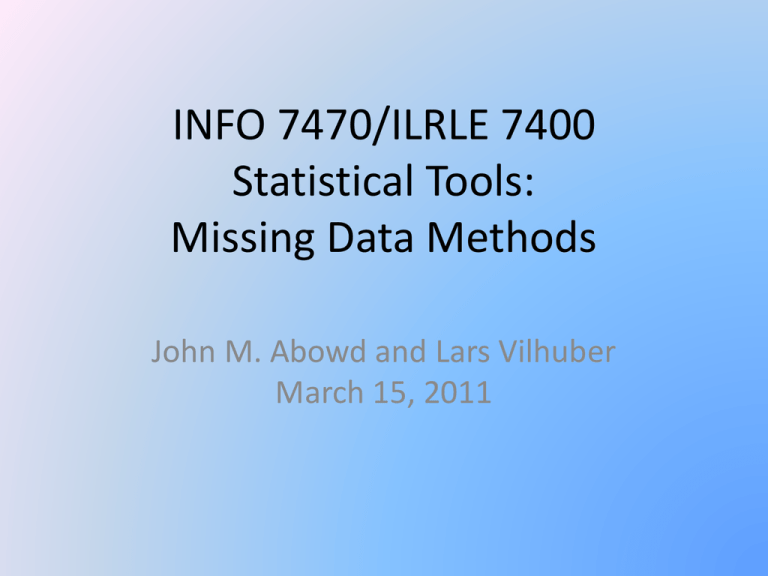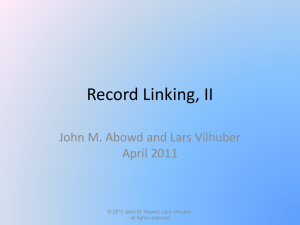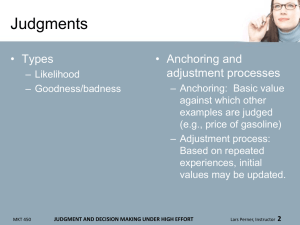
INFO 7470/ILRLE 7400
Statistical Tools:
Missing Data Methods
John M. Abowd and Lars Vilhuber
March 15, 2011
Outline
• Missing data overview
• Missing records
– Frame or census
– Survey
•
•
•
•
Missing items
Overview of different products
Overview of methods
Formal multiple imputation methods
3/15/2011
© John M. Abowd and Lars Vilhuber 2011,
all rights reserved
2
Missing Data Overview
• Missing data are a constant feature of both
sampling frames (derived from censuses) and
surveys
• Two important types are distinguished
– Missing record (frame) or interview (survey)
– Missing item (in either context)
• Methods differ depending upon type
3/15/2011
© John M. Abowd and Lars Vilhuber 2011,
all rights reserved
3
Missing Records: Frame or Census
• The problem of missing records in a census or
sampling frame is detection
• By definition in these contexts the problem
requires external information to solve
3/15/2011
© John M. Abowd and Lars Vilhuber 2011,
all rights reserved
4
Census of Population and Housing
• Dress rehearsal Census
• Pre-census housing list review
• Census processing of housing units found on a
block not present on the initial list
• Post-census evaluation survey
• Post-census coverage studies
3/15/2011
© John M. Abowd and Lars Vilhuber 2011,
all rights reserved
5
Economic Censuses and the Business
Register
•
•
•
•
•
Discussed in lecture 2
Start with tax records
Unduplication in the Business Register
Weekly updates
Multi-units updated with Company
Organization Survey
• Multi-units discovered during the inter-censal
surveys are added to the BR
3/15/2011
© John M. Abowd and Lars Vilhuber 2011,
all rights reserved
6
Missing Records: Survey
• Non-response in a survey is normally handled
within the sample design
• Follow-up (up to a limit) to obtain
interview/data
• Assessment of non-response within sample
strata
• Adjustment of design weights to reflect nonresponses
3/15/2011
© John M. Abowd and Lars Vilhuber 2011,
all rights reserved
7
Missing Items
• Imputation based on the other data in the
interview/case (relational imputation)
• Imputation based on related information on
the same respondent (longitudinal
imputation)
• Imputation based on statistical modeling
– Hot deck
– Cold deck
– Multiple imputation
3/15/2011
© John M. Abowd and Lars Vilhuber 2011,
all rights reserved
8
Census 2000 PUMS Missing Data
• Pre-edit: When the original entry was rejected
because it fell outside the range of acceptable
values.
• Consistency: Imputed missing characteristics
based on other information recorded for the
person or housing unit.
• Hot Deck: Supplied the missing information from
the record of another person or housing unit.
• Cold Deck: Supplied missing information from a
predetermined distribution.
3/15/2011
© John M. Abowd and Lars Vilhuber 2011,
all rights reserved
9
CPS Missing Data
• Relational imputation: use other information
in the record to infer value
• Longitudinal edits: use values from the
previous month if present in sample
• Hot deck: use values from actual respondents
whose data are complete for the, relatively
few, conditioning variables
3/15/2011
© John M. Abowd and Lars Vilhuber 2011,
all rights reserved
10
County Business Patterns
• The County and Zipcode Business Patterns data
are published from the Employer Business
Register
• This is important because variables used in these
publications are edited to publication standards
• The primary imputation method is a longitudinal
edit
• http://www.census.gov/epcd/cbp/view/cbpmethodology.htm
3/15/2011
© John M. Abowd and Lars Vilhuber 2011,
all rights reserved
11
Economic Censuses
• Like demographic products, there are usually
both edited and unedited versions of the
publication variables in these files
• Publication variables (e.g., payroll, employment,
sales, geography, ownership) have been edited
• Most recent files include allocation flags to
indicate that a publication variable has been
edited or imputed
• Many historical files include variables that have
been edited or imputed but do not include the
flags
3/15/2011
© John M. Abowd and Lars Vilhuber 2011,
all rights reserved
12
QWI Missing Data Procedures
• Individual data
– Multiple imputation
• Employer data
– Relational edit
– Bi-directional longitudinal edit
– Single-value imputation
• Job data
– Use multiple imputation of individual data
– Multiple imputation of place of work
• Use data for each place of work
3/15/2011
© John M. Abowd and Lars Vilhuber 2011,
all rights reserved
13
BLS National Longitudinal Surveys
• Non-responses to the first wave never enter
the data
• Non-responses to subsequent waves are
coded as “interview missing”
• Respondent are not dropped for missing an
interview. Special procedures are used to fill
critical items from missed interviews when the
respondent is interviewed again
• Item non-response is coded as such
3/15/2011
© John M. Abowd and Lars Vilhuber 2011,
all rights reserved
14
Federal Reserve Survey of Consumer
Finances (SCF)
• General information on the Survey of
Consumer Finances:
http://www.federalreserve.gov/pubs/oss/oss2/scfindex.html
• Missing data and confidentiality protection
are handled with the same multiple
imputation procedure
3/15/2011
© John M. Abowd and Lars Vilhuber 2011,
all rights reserved
15
SCF Details
• Survey collects detailed wealth information from an
over-sample of wealthy households
• Item refusals and item non-response are rampant (see
Kennickell article)
• When there is item refusal, interview instrument
attempts to get an interval
• The reported interval is used in the missing data
imputation
• When the response is deemed sensitive for
confidentiality protection, the response is treated as an
item missing (using the same interval model as above)
• First major survey released with multiple imputation.
3/15/2011
© John M. Abowd and Lars Vilhuber 2011,
all rights reserved
16
Relational Imputation
• Uses information from the same respondent
• Example: respondent provided age but not
birth date. Use age to impute birth date.
• Example: some members of household have
missing race/ethnicity data. Use other
members of same household to impute
race/ethnicity
3/15/2011
© John M. Abowd and Lars Vilhuber 2011,
all rights reserved
17
Longitudinal Imputation
• Look at the respondent’s history in the data to
get the value
• Example: respondent’s employment
information missing this month. Impute
employment information from previous
month
• Example: establishment industry code missing
this quarter. Impute industry code from most
recently reported code
3/15/2011
© John M. Abowd and Lars Vilhuber 2011,
all rights reserved
18
Cross Walks and Other Imputations
• In business data, converting an activity code
(e.g., SIC) to a different activity code (e.g.,
NAICS) is a form of missing data
• In general, the two activity codes are not done
simultaneously for the same entity
• Often these imputations are treated as 1-1
when they are, in fact, many-to-many
3/15/2011
© John M. Abowd and Lars Vilhuber 2011,
all rights reserved
19
Probabilistic Methods for Cross Walks
• Inputs:
– original codes
– new codes
– information for computing
• Pr(new code | original code, other data)
• Processing
– Randomly assign a new code from the appropriate
conditional distribution
• See Lab 8
3/15/2011
© John M. Abowd and Lars Vilhuber 2011,
all rights reserved
20
The Theory of Missing Data Models
•
•
•
•
•
•
General principles
Missing at random
Weighting procedures
Imputation procedures
Hot decks
Introduction to model-based procedures
3/15/2011
© John M. Abowd and Lars Vilhuber 2011,
all rights reserved
21
General Principles
• Most of today’s lecture is taken from Statistical
Analysis with Missing Data, 2nd edition, Roderick
J. A. Little and Donald B. Rubin (New York: John
Wiley & Sons, 2002).
• The basic insight is that missing data should be
modeled using the same probability and
statistical tools that are the basis of all data
analysis.
• Missing data are not an anomaly to be swept
under the carpet.
• They are an integral part of very analysis.
3/15/2011
© John M. Abowd and Lars Vilhuber 2011,
all rights reserved
22
Missing Data Patterns
•
•
•
•
•
•
Univariate non-response
Multivariate non-response
Monotone
General
File matching
Latent factors, Bayesian parameters
3/15/2011
© John M. Abowd and Lars Vilhuber 2011,
all rights reserved
23
Missing Data Mechanisms
• The complete data are
defined as the matrix Y (n
K).
• The pattern of missing data
is summarized by a matrix
of indicator variables M (n
K).
• The data generating
mechanism is summarized
by the joint distribution of Y
and M.
0, if yij is observed
mij
1, if yij is missing
3/15/2011 © John M. Abowd and Lars Vilhuber 2011, all rights reserved
pY , M ,
24
Missing Completely at Random
• In this case the missing data mechanism does not
depend upon the data Y.
• This case is called MCAR.
p ( M Y , , ) p M
3/15/2011 © John M. Abowd and Lars Vilhuber 2011, all rights reserved
25
Missing at Random
• Partition Y into
observed and
unobserved parts.
• Missing at random
means that the
distribution of M
depends only on the
observed parts of Y.
• Called MAR.
Y Yobs ,Ymis
p( M Y , , ) p( M Yobs , )
3/15/2011 © John M. Abowd and Lars Vilhuber 2011, all rights reserved
26
Not Missing at Random
• If the condition for MAR fails, then we say that
the data are not missing at random, NMAR.
• Censoring and more elaborate behavioral
models often fall into this category.
3/15/2011
© John M. Abowd and Lars Vilhuber 2011,
all rights reserved
27
The Rubin and Little Taxonomy
•
•
•
•
Analysis of the complete records only
Weighting procedures
Imputation-based procedures
Model-based procedures
3/15/2011
© John M. Abowd and Lars Vilhuber 2011,
all rights reserved
28
Analysis of Complete Records Only
• Assumes that the data are MCAR.
• Only appropriate for small amounts of missing
data.
• Used to be common in economics, less so in
sociology.
• Now very rare.
3/15/2011
© John M. Abowd and Lars Vilhuber 2011,
all rights reserved
29
Weighting Procedures
• Modify the design weights to correct for
missing records.
• Provide an item weight (e.g., earnings and
income weights in the CPS) that corrects for
missing data on that variable. See Bollinger
and Hirsch discussion later in lecture.
• See complete case and weighted complete
case discussion in Rubin and Little.
3/15/2011
© John M. Abowd and Lars Vilhuber 2011,
all rights reserved
30
Imputation-based Procedures
• Missing values are filled-in and the resulting
“Completed” data are analyzed
– Hot deck
– Mean imputation
– Regression imputation
• Some imputation procedures (e.g., Rubin’s
multiple imputation) are really model-based
procedures.
3/15/2011
© John M. Abowd and Lars Vilhuber 2011,
all rights reserved
31
Imputation Based on Statistical
Modeling
• Hot deck: use the data from related cases in
the same survey to impute missing items
(usually as a group)
• Cold deck: use a fixed probability model to
impute the missing items
• Multiple imputation: use the posterior
predictive distribution of the missing item,
given all the other items, to impute the
missing data
3/15/2011
© John M. Abowd and Lars Vilhuber 2011,
all rights reserved
32
Current Population Survey
• Census Bureau Imputation Procedures:
– Relational Imputation
– Longitudinal Edit
– Hot Deck Allocation Procedure
3/15/2011
© John M. Abowd and Lars Vilhuber 2011,
all rights reserved
33
“Hot Deck” Allocation
• Labor Force Status
– Employed
– Unemployed
– Not in the Labor Force
(Thanks to Warren Brown)
3/15/2011
© John M. Abowd and Lars Vilhuber 2011,
all rights reserved
34
“Hot Deck” Allocation
Black
Non-Black
Male
16 – 24
25+
ID #0062
Female
16-24
25+
3/15/2011
© John M. Abowd and Lars Vilhuber 2011,
all rights reserved
35
“Hot Deck” Allocation
Black
Non-Black
Male
16 – 24
ID #3502
ID #1241
25+
ID #8177
ID #0062
16-24
ID #9923
ID #5923
25+
ID #4396
ID #2271
Female
3/15/2011
© John M. Abowd and Lars Vilhuber 2011,
all rights reserved
36
CPS Example
• Effects of hot-deck imputation of labor force
status.
3/15/2011
© John M. Abowd and Lars Vilhuber 2011,
all rights reserved
37
Public Use Statistics
Total A_LFSR
Working
W/job,not at work
Unemp,looking for work
Unemp,on layoff
Not in labor force
Total AXLFSR
220,284,576
131,704,236
4,572,653
7,967,976
1,371,469
74,668,242
Total A_AGE
Average A_AGE
Std Err A_AGE
220,284,576
44.1
0.15
Total A_SEX
Male
Female
220,284,576
105,972,746
114,311,831
3/15/2011
No change
© John M. Abowd and Lars Vilhuber 2011,
all rights reserved
Allocated
38
Allocated v. Unallocated
Total AXLFSR
220,284,576
131,704,236
4,572,653
7,967,976
1,371,469
74,668,242
No change
219,529,643
131,294,888
4,564,589
7,919,562
1,367,766
74,382,838
Allocated
754,933
409,348
8,063
48,414
3,703
285,405
Total A_AGE
Average A_AGE
Std Err A_AGE
220,284,576
44.1
0.15
219,529,643
44.2
0.15
754,933
35.2
1.96
Total A_SEX
Male
Female
220,284,576
105,972,746
114,311,831
219,529,643
105,603,454
113,926,189
754,933
369,292
385,641
Total A_LFSR
Working
W/job,not at work
Unemp,looking for work
Unemp,on layoff
Not in labor force
3/15/2011
© John M. Abowd and Lars Vilhuber 2011,
all rights reserved
39
Bollinger and Hirsch CPS Missing Data
• Studies the particular assumptions in the CPS
hot deck imputer on wage regressions
• Census Bureau uses too few variables in its
hot deck model
• Inclusion of additional variables improves the
accuracy of the missing data models
• See Bollinger and Hirsch
3/15/2011
© John M. Abowd and Lars Vilhuber 2011,
all rights reserved
40
Model-based Procedures
• A probability model based on p(Y, M) forms
the basis for the analysis.
• This probability model is used as the basis for
estimation of parameters or effects of
interest.
• Some general-purpose model-based
procedures are designed to be combined with
likelihood functions that are not specified in
advance.
3/15/2011
© John M. Abowd and Lars Vilhuber 2011,
all rights reserved
41
Little and Rubin’s Principles
• Imputations should be
– Conditioned on observed variables
– Multivariate
– Draws from a predictive distribution
• Single imputation methods do not provide a
means to correct standard errors for
estimation error.
3/15/2011
© John M. Abowd and Lars Vilhuber 2011,
all rights reserved
42
Rest of lecture (PDF format)
Applications to Complicated Data
• Computational formulas for MI data
• Examples of building Multiply-imputed data
files
3/15/2011
© John M. Abowd and Lars Vilhuber 2011,
all rights reserved
44
Computational Formulas
• Assume that
you want to
estimate
something as a
function of the
data Q(Y)
• Formulas
account for
missing data
contribution to
variance
Qm Y m estimandfrom them th implicate
M
Q Qm Y m
M
m 1
Q averageestimand
Vm Y m covariancematrixof Qm Y m from them th implicate
M
V Vm Y m
M
m 1
V averagecovariancematrix
T
M
B Qm Y m Q Qm Y m Q M
m 1
B bet ween implicatevariat ionof Qm Y m
1
T V 1 B
M
T tot alvariancematrixof QY
3/15/2011 © John M. Abowd and Lars Vilhuber 2011, all rights reserved
45
Examples
• Survey of Consumer Finances
• Quarterly Workforce Indicators
3/15/2011
© John M. Abowd and Lars Vilhuber 2011,
all rights reserved
46
Survey of Consumer Finances
• Codebook description of missing data procedures
3/15/2011
© John M. Abowd and Lars Vilhuber 2011,
all rights reserved
47
How are the QWIs Built?
• Raw input files:
–
–
–
–
–
UI wage records
QCEW/ES-202 EQUI report
Census Numident/Personal Characteristics File
Census Place of Residence
LEHD geo-coding system
• Processed data files:
– Individual characteristics
– Employer characteristics
– Employment history with earnings
3/15/2011
© John M. Abowd and Lars Vilhuber 2011,
all rights reserved
48
Flow Chart
Processing the Input Files
• Each quarter the complete history of every
individual, every establishment, and every job
is processed through the production system
• Missing data on the individual and
employment history records are multiply
imputed
• Missing data on the employer characteristics
are singly-imputed (explanation to follow)
3/15/2011
© John M. Abowd and Lars Vilhuber 2011,
all rights reserved
50
Garden Variety Problems
• Missing demographic data on the individual file
(birth date, sex, education, place of residence)
– Multiple imputations using information from the
individual, establishment, and employment history
files
– Model estimation component updated every quarter
• This process was used to create the current
snapshot (S2004/S2008) but not the current
public-use data (updated individual data
imputation procedure uses much more
information)
3/15/2011
© John M. Abowd and Lars Vilhuber 2011,
all rights reserved
51
The Mother of all Missing Data
Problems
• The employment history records only code
employer to the UI account level
• Establishment characteristics (industry, geocodes) are missing for multi-unit establishments
• The establishment (within UI account) is multiply
imputed using a dynamic multi-stage probability
model
• Estimation of the posterior predictive distribution
depends on the existence of a state with
establishments coded on the UI wage record
(MN)
3/15/2011
© John M. Abowd and Lars Vilhuber 2011,
all rights reserved
52
Can It Be Done?
• Every quarter the QWI processes over 6 billion
employment histories (unique person-employer pair)
covering 1990 to 2010
• Approximately 30% of these histories require multiple
employer imputations
• So, the system does more than 25 billion full
information imputations every quarter
• The information used for the imputations is current, it
includes all of the historical information for the person
and every establishment associated with that person’s
UI account
3/15/2011
© John M. Abowd and Lars Vilhuber 2011,
all rights reserved
53
Does It Work?
• Full assessment using the state that codes
both
• Summary slide follows
3/15/2011
© John M. Abowd and Lars Vilhuber 2011,
all rights reserved
54
MN Known Unit vs. MN Imputed Unit
Weighted
20%
15%
Earnings, Full-Quarter Accessions
10%
Beginning-of-Period Employment
End-of-Period Employment
5%
Percent
Discrepancy
Full-Quarter Employment
0%
Separations
-5%
Accessions
-10%
-15%
10th Percentile
3/15/2011
Median
© John M. Abowd and Lars Vilhuber 2011,
all rights reserved
90th Percentile
55










